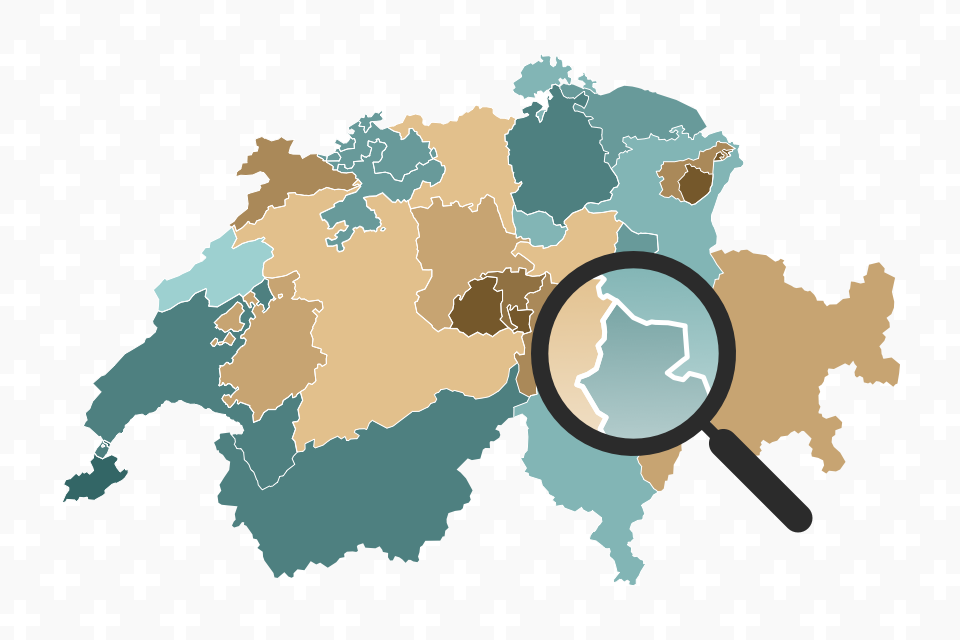Using Swiss gadgets to fight crime in Estonia

Estonia should be solving some crimes faster in future, armed with Swiss technologies that allow for bodies to be examined digitally and without an autopsy.
Forensic doctors and criminologists solve cases by literally splitting hairs and other tiny particles.
“I’ve been to Switzerland many times,” Üllar Lanno, director of Estonia’s forensic science institute, tells swissinfo.ch.
“As the head of marketing of Toyota Estonia, I used to visit the Geneva Motor Show.” So, just how did the former Toyota salesman move into forensic science?
Lanno reveals all later, after we have toured his institute. Spread across three old locations for the time being, the new building on the outskirts of Tallinn is complete except for the interior.
“We will accommodate more than 40 forensic departments on 16 floors – forensic medicine, court psychology, cyber crime, criminology, databases, the public prosecutor’s office and the bomb disposal unit,” says Lanno proudly.
Sixteen floors? – “Yes, seven above ground and nine underground,” he explains.
We take the steps, still without banisters, into the basement. Right below the coroners’ future offices the rooms are tiled in white.
“This is where the two Virtobot units will be kept – the scanners that were financed and developed in Switzerland,” says Lanno.
“With them, it will no longer be necessary to cut open the body to find out about the cause of death or injury or the exact time of death.”
3-D images
“We can also scan live people to detect dental positions, injuries and consequences of surgery and compare the images with national or international criminal databases.”
The name Virtobot refers to the fact that it is an industrial robot for virtual autopsies. It produces a high-precision three-dimensional image of the body and was developed by the Institute of Forensic Medicine at Bern University.
It works with the help of magnet resonance scanners and computed tomography scanners which are also used for diagnosing illnesses.
With the high-tech equipment, developed with funds from the Swiss National Science Foundation, bodies can be digitally preserved and an autopsy can be repeated years later if new evidence crops up in an unsolved case.
“We can also make images available immediately, via Interpol or other investigation authorities,” Lanno says.
EU cooperation
In an effort to reduce Estonia’s crime rate, which is higher than that of the European Union’s 15 “old” countries prior to eastern expansion in 2004, the government has recently implemented a series of reforms.
For example, all the country’s forensic activities were merged into one unit under the justice ministry. “The decentralisation was a legacy of the days of the Soviet Union,” says Lanno.
He blames Estonia’s high crime rate on the fact that it is a transit country between Russia and Scandinavia.
The border to Russia is one of the EU’s outer boundaries. “We therefore work very closely with the EU countries,” Lanno points out.
Perfect timing
Switzerland is paying SFr3.5 million ($3.4 million) towards the forensic institute’s high-tech infrastructure costs. It is part of the Swiss contribution that aims to reduce the social and economic disadvantages of the new EU countries after the union’s eastward enlargement.
The amount also includes the purchase of a new, extremely high-resolution microscope as well as training.
“These microscopes, which are able to identify tiny particles of gun powder, tend to last ten years. Our current microscope is exactly that age. The assistance from Switzerland is therefore perfectly timed,” Lanno says.
In the coming weeks and months, the new building will gradually be put into operation. Construction workers are about to finish painting the walls and laying the floors.
It’s pitch-dark in the basement but there is noise coming from one of the rooms. “That’s a 300m shooting range for the police,” Lanno points out while searching in vain for a light switch.
Cars
Next door is a large room with high ceilings and an access ramp.
“This is our garage. We bring stolen cars here, spray them with a type of foam and remove it again. It allows us to quickly find finger prints and suspicious particles and we can also see if the car has been resprayed,” he explains.
Driving back to the city centre, Lanno finally explains how he ended up in this role.
“As a medical doctor I worked in hospitals for a long time,” Lanno recounts.
“That is why I speak the same language as coroners. It is a huge advantage in this fascinating job. Forensics and cars – both are closely involved with the latest technologies.”
Andreas Keiser in Tallinn, swissinfo.ch (Adapted from German by Urs Geiser)
As part of a second set of bilateral treaties with Brussels, non-EU member Switzerland pledged SFr1 billion ($950 million) to the ten new EU member states mainly in eastern Europe.
Swiss voters endorsed the government plan in a nationwide vote in 2006.
Bulgaria and Romania which joined the EU in 2007 also benefit from Swiss funds.
A total of SFr39 million will be spent on projects in Estonia by 2012.
The Swiss contribution is part of efforts to reduce social and economic disparities in the enlarged EU and to ensure security, stability and prosperity throughout the continent.
Switzerland paid about SFr3.45 billion towards the transition of eastern and central European states between 1990 and 2006.
A further SFr730,000 has been earmarked for non-EU member states for the 2007-2011 period.
The EU cohesion fund is aimed at member states whose Gross National Income (GNI) per inhabitant is less than 90% of the union’s average.
Switzerland’s contribution is implemented autonomously and is not part of the EU’s cohesion policy.
The cohesion fund finances activities under the following categories: trans-European transport networks and environment, including energy efficiency, renewable energy.
The financial assistance of the cohesion fund can be suspended by a council decision if a member state shows excessive public deficit.

In compliance with the JTI standards
More: SWI swissinfo.ch certified by the Journalism Trust Initiative














You can find an overview of ongoing debates with our journalists here . Please join us!
If you want to start a conversation about a topic raised in this article or want to report factual errors, email us at english@swissinfo.ch.